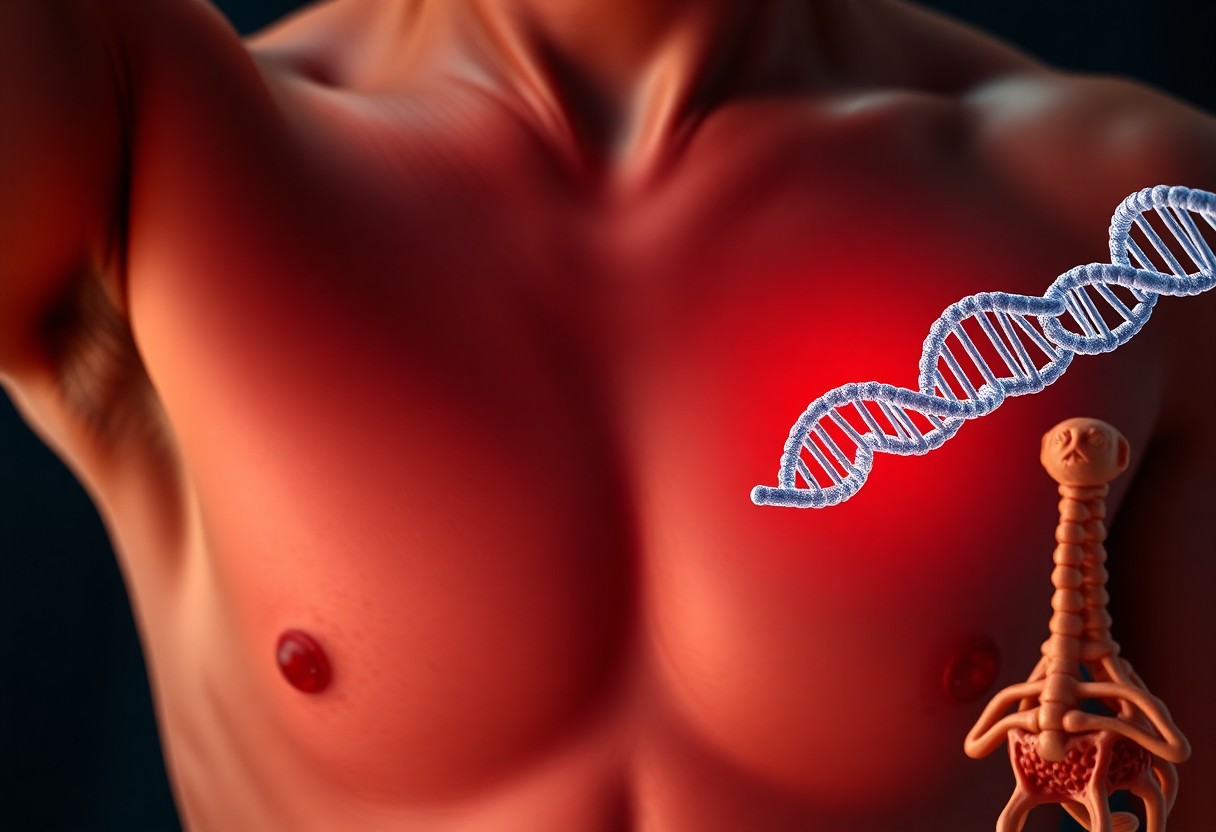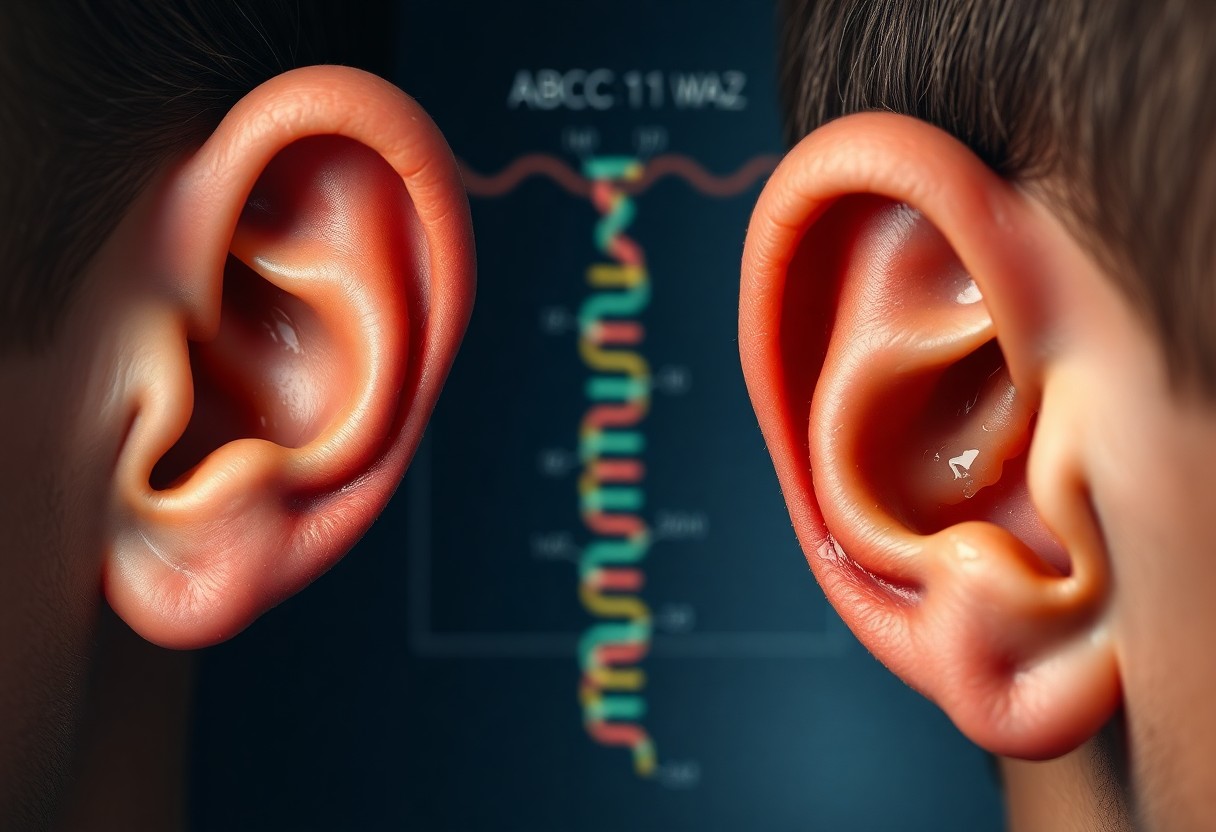Earwax type is more than just a biological curiosity; it reflects the influence of your genetics, specifically the ABCC11 gene. This gene determines whether your earwax is wet or dry, impacting personal hygiene and even body odor. Understanding the ABCC11 gene can offer insights into your ancestral background and certain health traits. By exploring the science behind earwax types, you gain a greater appreciation for how genetics shape various aspects of your life.
Key Takeaways:
- The ABCC11 gene determines earwax type, with variants leading to either wet or dry earwax.
- Dry earwax is primarily found in populations of East Asian descent, while wet earwax is more common in African and European populations.
- The presence of the ABCC11 variant also influences body odor and other traits linked to apocrine glands.
The Genetics of the ABCC11 Gene
Location and Structure of ABCC11
The ABCC11 gene is located on chromosome 16, specifically at position 16q12.2. It spans approximately 88,000 base pairs and encodes for a protein belonging to the ATP-binding cassette (ABC) transporter family. This protein facilitates the transport of various molecules across cellular membranes, playing a significant role in physiological processes.
Function of the ABCC11 Gene in the Body
The ABCC11 gene is primarily responsible for the production of a protein that transports substances across cell membranes, including lipids and drugs. This function is critical for proper glandular secretion, influencing not just earwax type but also aspects of body odor and sweat production, contributing to individual differences in these traits.
This gene’s protein product operates in several tissues, including the apocrine glands of the skin. It helps regulate the secretion of sweat, specifically aiding in the release of lipids and metabolites that influence odor production. Variability in ABCC11 activity can lead to differences in body odor, which impacts social interactions and perceptions of attractiveness. Understanding this function provides insights into how genetics affect your unique physical traits.
Genetic Variants and Polymorphisms
The Scientific Classification of Earwax Types
The classification of earwax types primarily includes two categories: wet and dry. Wet earwax is typically moist, sticky, and brownish, while dry earwax appears flaky and light yellow. These distinctions are genetically determined, with the ABCC11 gene playing a significant role in their manifestation. This genetic variability can be attributed to different alleles that govern the secretion of earwax components.
- Wet earwax is associated with a dominant allele.
- Dry earwax is linked to a recessive allele.
- Distribution of earwax types varies by ethnicity.
- ABCC11 gene polymorphisms influence earwax appearance.
- Perceiving these characteristics can enhance genetic understanding.
| Earwax Type | Genetic Basis |
|---|---|
| Wet | Dominant allele |
| Dry | Recessive allele |
| Frequency in East Asian Populations | High prevalence of dry earwax |
| Frequency in European Populations | Higher occurrence of wet earwax |
| Global Distribution | Varies significantly among ethnic groups |
Distribution of Wet and Dry Earwax in Populations
Your genetic background plays a significant role in the distribution of wet and dry earwax across populations. Studies show a stark contrast between ethnic groups, with East Asians exhibiting a high prevalence of dry earwax, while individuals of African and European descent often demonstrate a higher frequency of wet earwax. Regional variations further emphasize the genetic influence on earwax phenotypes.
This distribution underscores the idea that your ancestry contributes to whether you will produce wet or dry earwax. In East Asian populations, about 90% have dry earwax, while European and African populations show a predominant occurrence of wet earwax at varying rates. Understanding these percentages can reveal insights into evolutionary adaptations and genetic diversity.
Correlation Between ABCC11 and Earwax Phenotypes
The ABCC11 gene not only determines the type of earwax you have but also correlates with other phenotypic traits. This gene influences body odor, with dry earwax carriers generally producing less body odor compared to those with wet earwax. Studies have identified specific alleles, such as rs17822931, which directly affect earwax consistency.
- Wet earwax often coincides with strong body odor production.
- Dry earwax carriers typically have less body odor.
- Genetic testing can reveal your earwax type.
- Cultural implications exist regarding body odor perceptions.
- Thou may find your earwax type influences social interactions.
| Phenotype | Characteristic |
|---|---|
| Wet Earwax | Sticky, moist |
| Dry Earwax | Flaky, dry |
| Body Odor | Stronger in wet earwax types |
| Genetic Testing | Identifies ABCC11 variants |
| Cultural Differences | Varying perceptions of body odor |

The Role of ABCC11 in Sweating and Body Odor
Link Between ABCC11 and Apocrine Gland Activity
The ABCC11 gene plays a significant role in the functioning of apocrine glands, which are responsible for producing sweat that contributes to body odor. Individuals with the active form of the ABCC11 gene tend to have more active apocrine glands, leading to greater production of odoriferous sweat, particularly in areas such as the armpits. In contrast, those with the inactive variant typically experience a decreased sweat output from these glands.
The Impact of Earwax Genotype on Body Odor
Your earwax genotype can directly influence your body odor, primarily due to its correlation with ABCC11 activity. Those with the wet earwax phenotype harbor the functional variant of the ABCC11 gene, associated with a more pronounced secretion from apocrine glands. This results in a stronger body odor, while individuals with dry earwax, who carry a non-functional variant, generally produce less of this sweat, leading to milder body odor.
The relationship between your earwax type and body odor involves biochemical pathways influenced by ABCC11. Research indicates that people with the wet earwax genotype, due to their heightened apocrine gland activity, may produce sweat rich in fatty acids and proteins, leading to a more pungent odor when metabolized by skin bacteria. This illustrates how genetic factors mold personal hygiene experiences and perceptions, creating significant variability within populations.
Evolutionary Perspectives on ABCC11
The Adaptive Significance of Earwax Types in Human Survival
Your earwax type may have played a role in human survival. The wet type, more likely to occur in ancestors from humid environments, aids in trapping dirt and pathogens, promoting ear health. In contrast, the dry type, prevalent in arid regions, offers advantages in preventing moisture accumulation and bacterial growth.
- Wet earwax is linked to higher hydration levels.
- Dry earwax is more effective for arid environments.
- Genetic variations affect earwax type distribution globally.
- Earwax type may relate to climate adaptation.
- Recognizing the significance of your earwax type allows insight into your ancestral background.
| Earwax Type | Environment Adaptation |
| Wet | Humid, tropical regions |
| Dry | Arid, dry climates |
| Genetic Variation | Global population distribution |
| Health Function | Dirt/pathogen trapping |
How Environmental Factors Influence Genetic Expression
Your environment significantly shapes genetic expression, influencing traits like earwax type. Factors such as climate, diet, and lifestyle can interact with your genes, leading to varying phenotypic expressions across different populations.
- Humidity levels affect hydration and metabolic processes.
- Diets rich in specific nutrients alter gene expression.
- Lifestyle choices can lead to epigenetic changes.
- Temperature influences biochemical processes in the body.
- After considering these factors, you understand that genetic traits are not solely predetermined.
Studies indicate that certain environmental challenges can induce modifications in gene activity. For instance, a diet high in omega-3 fatty acids can enhance the expression of genes related to inflammation, while high-sugar diets may suppress them. Understanding these interactions helps you appreciate the complexity of genetic traits like earwax type.
- Food availability shapes genetic responses.
- Migration patterns contribute to genetic diversity.
- Pollution exposure can alter gene expressions over generations.
- Microbial exposure in your environment affects immune system genes.
- After analyzing these influences, you see how environmental factors mold your genetic landscape.
Cultural and Social Implications of Earwax Type
Perceptions of Hygiene and Earwax in Different Cultures
Your understanding of hygiene can be influenced by cultural perceptions of earwax. In some societies, particularly in Western cultures, dry earwax is often associated with better hygiene standards, while wet earwax may carry negative connotations. Conversely, in regions where wet earwax is common, it can be viewed as a normative and less stigmatized trait. Such varying beliefs highlight the role of cultural narratives in shaping ideas around personal cleanliness.
The Influence of Earwax Type on Personal Identity
Earwax type can subtly impact personal identity, as it may influence social interactions and self-perception. Individuals with dry earwax may identify with certain ethnic backgrounds, while those with wet earwax might embrace aspects of their heritage. Additionally, in environments where physical traits are often linked to stereotypes, your earwax type could unintentionally alter how you are perceived, affecting social dynamics and even opportunities.
The relationship between earwax type and personal identity illustrates how genetic traits can intersect with cultural narratives. If you belong to a community where wet or dry earwax predominates, this characteristic might resonate with your cultural identity, fostering a sense of belonging. Furthermore, social interactions often reflect underlying biases; for example, you might notice an inclination toward associating with others who share similar traits. Awareness of this influence can lead to a deeper understanding of your own identity and the cultural landscape surrounding you.
Practical Applications and Genetic Testing
How ABCC11 Testing Can Offer Insights into Personal Health
ABCC11 testing can reveal not only your earwax type but also potential health implications. Research indicates that individuals with dry earwax may experience lower risks of certain conditions, such as chronic ear infections and some forms of body odor, linked to the gene’s influence on apocrine gland function. Understanding your genetic predisposition can aid in personal health decisions and lifestyle adjustments.
Potential for Genetic Engineering and Future Research
The future of genetic engineering utilizing the ABCC11 gene is promising, with applications extending to personalized medicine and therapeutic interventions. By identifying genetic variations, researchers are exploring targeted treatments that could influence earwax production and related conditions. Gene editing technologies, such as CRISPR, present opportunities to directly manipulate the ABCC11 gene, potentially altering phenotypic traits associated with earwax type and sweat production.
Future research may focus on the broader implications of ABCC11 beyond earwax type, including its role in sweat gland activity and body odor regulation. Studies could investigate how variations in this gene affect personal health, including susceptibility to certain diseases or skin conditions. By exploring these connections, scientists may develop new strategies for hygiene and health management, enhancing quality of life for individuals with specific genetic profiles. This ongoing research could lead to advancements in personalized therapies targeting lifestyle-related health issues linked to the ABCC11 gene.

The Interplay Between Genetics and Environment
How Lifestyle Choices Affect Gene Expression
Your lifestyle choices can significantly influence gene expression, a phenomenon known as epigenetics. Factors such as diet, exercise, and stress levels interact with your genetic makeup, potentially activating or silencing specific genes. For example, a diet rich in antioxidants can protect against oxidative stress, affecting genes involved in metabolism and aging. Physical activity may also enhance the expression of genes related to muscle growth and endurance. Thus, what you eat and how you live can shape your genetic potential over time.
Understanding Gene-Environment Interaction Through ABCC11
The ABCC11 gene not only determines earwax type but also demonstrates how environmental factors can influence genetic traits. Your environment, including climate and hygiene habits, can modify the expression of the ABCC11 gene, affecting your earwax’s consistency. For instance, overheating caused by high temperatures may lead to increased earwax production in individuals with wet-type earwax, while lower humidity may have the opposite effect. This interaction underlines the dynamic relationship between your genetics and the environment you inhabit.
This gene-environment interplay exemplifies how various external factors can impact genetic expression in practical terms. In populations where high humidity is prevalent, individuals may experience more active ABCC11 expression, resulting in wet earwax. Conversely, in arid regions, the gene may decrease its activity, aligning with dry earwax production. Research indicates that lifestyle modifications, such as adopting different hygiene practices, can also shape this interaction, demonstrating that while genetics set a foundation, your choices and environment play critical roles in how traits manifest. Such insights can lead to personalized approaches to health and wellness based on individual genetic profiles.
Summing up
With this in mind, understanding the ABCC11 gene enhances your awareness of the genetic factors influencing your earwax type. The presence of a specific allele determines whether your earwax is wet or dry, showcasing the fascinating link between genetics and phenotypic characteristics. By exploring this genetic perspective, you gain insight into the biological underpinnings of seemingly simple traits, enriching your comprehension of human diversity.
FAQ
Q: What is the ABCC11 gene?
A: The ABCC11 gene encodes a protein that is involved in the transport of various substances across cellular membranes. This gene is particularly known for its role in determining earwax type.
Q: How does the ABCC11 gene influence earwax type?
A: The ABCC11 gene has two main variants: one that leads to dry earwax and another that results in wet earwax. The dry earwax variant is associated with a single nucleotide change, affecting the expression of the ABCC11 protein.
Q: Is earwax type hereditary?
A: Yes, earwax type is hereditary and tied to the genetic variants of the ABCC11 gene. Individuals inherit these variants from their parents, which determines whether they have dry or wet earwax.
Q: Are there any health implications associated with earwax types related to the ABCC11 gene?
A: Generally, the type of earwax does not have direct health implications. However, individuals with dry earwax may have a lower incidence of certain ear infections compared to those with wet earwax.
Q: How can one determine their earwax type genetically?
A: Earwax type can be determined through genetic testing, which analyzes the ABCC11 gene. This testing can reveal the specific variants present and indicate whether a person is predisposed to dry or wet earwax.



